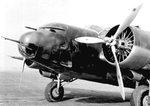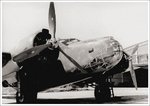- Thread starter
- #41
The Caproni Ca.135 was an Italian medium bomber designed in Bergamo in Italy by Cesare Pallavicino. It flew for the first time in 1935, and entered service with the Peruvian Air Force in 1937, and with the Regia Aeronautica (Italian Royal Air Force) in January 1938. Production of the aircraft was initially 32 aircraft, of which eight were Ca.135Ss, some were converted into the Ca.135Mod. The first Ca.135Bis were built in 1938. They were fitted with 746 kW (1,000 hp) Piaggio P.XI RC.40 engines, with Piaggio P.1001 three-blade metal propellers. Length was 17.7 m (58.1 ft), wingspan 18.8 m (61.7 ft), and wing surface 60 m² (646 ft²). Armament was still only two 12.7 mm (0.5 in) guns and one 7.7 mm (0.303 in), but the nose was redesigned to be more aerodynamic. Another 32 aircraft were ordered and built between 1939 and June 1940.
They were not successful aircraft, being heavily criticized by the Italian pilots. Unable to be used operationally, they were sent to flying schools, and then exported to Hungary. The first batch of Ca.135s flown by 11 Wing were phased out by late 1938. 25 were still available at Jesi airfield, but only four were airworthy. The others were probably in maintenance for engine replacement. There were at least 15 Ca.135Ss and Ca.135Mods at the Malpensa flying school in 1940, the poor condition of these aircraft meant that they were scrapped in November 1941. With the scrapping of the first batch and the selling of the second, all 64 Ca.135s left the service of the Regia Aeronautica without performing a single operational mission.
They were not successful aircraft, being heavily criticized by the Italian pilots. Unable to be used operationally, they were sent to flying schools, and then exported to Hungary. The first batch of Ca.135s flown by 11 Wing were phased out by late 1938. 25 were still available at Jesi airfield, but only four were airworthy. The others were probably in maintenance for engine replacement. There were at least 15 Ca.135Ss and Ca.135Mods at the Malpensa flying school in 1940, the poor condition of these aircraft meant that they were scrapped in November 1941. With the scrapping of the first batch and the selling of the second, all 64 Ca.135s left the service of the Regia Aeronautica without performing a single operational mission.




